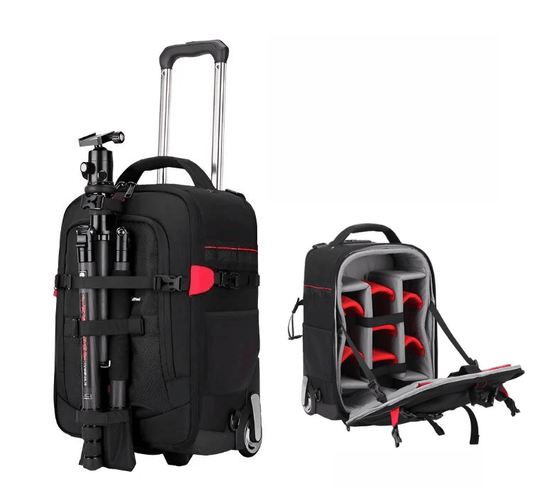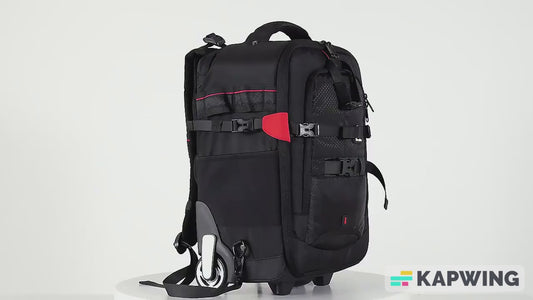Staying Fire-Safe While Camping in California: A Comprehensive Guide for 2025
In the wake of the devastating 2025 California wildfires, the importance of fire safety for campers in California's wildlands has never been more critical. As we navigate through increasingly severe fire seasons, understanding and implementing proper fire safety measures is crucial for both personal safety and environmental protection. This comprehensive guide will equip you with the knowledge and skills necessary to stay fire-safe while enjoying California's stunning natural landscapes.
The Stark Reality of California's 2025 Wildfires
The 2025 California wildfires have painted a grim picture of the state's vulnerability to these natural disasters. Beginning on January 7, 2025, these fires have wreaked havoc across Southern California, resulting in 11 fatalities, forcing nearly 180,000 evacuations, and destroying or damaging over 13,400 structures. As of January 11, 2025, the fires have consumed 4,021 acres and remain 0% contained, highlighting the urgent need for stringent fire safety measures.
Understanding Fire Risks in California's Wildlands
Historical Context and Current Relevance
California's history with wildfires is long and complex, but recent years have seen an alarming increase in both frequency and intensity. The 2020 wildfire season stands as the deadliest and most destructive in Southern California's recorded history, a sobering benchmark that underscores the escalating threat.
Climate change has played a significant role in exacerbating fire risks. Hotter temperatures, prolonged drought conditions, and changing wind patterns have created an environment ripe for fire spread. The fire season now starts earlier and lasts longer, affecting areas for extended periods and resulting in more extreme events.
Latest Statistics on Wildfire Damage and Spread
The 2025 Southern California wildfires serve as a stark reminder of the potential for rapid and devastating fire spread:
- 4,021 acres burned
- 11 fatalities
- Nearly 180,000 evacuations
- Over 13,400 structures destroyed or damaged
These numbers are part of a larger trend of increasing wildfire intensity. The Palisades fire, burning 2,921 acres, and the Eaton fire, consuming 200 acres, are just two examples of the significant fires that make up the current wildfire season.
Factors Contributing to Increased Fire Risks
- Climate Change Impacts: Rising temperatures and altered precipitation patterns have led to drier vegetation and more frequent drought conditions.
- Drought Conditions: Prolonged periods of drought have left California's landscapes parched and highly susceptible to fire.
- Wind Patterns: Strong, dry winds like the Santa Ana winds can rapidly spread fires and make containment efforts challenging.
Fire Hazard Severity Zone (FHSZ) Maps
CAL FIRE utilizes Fire Hazard Severity Zone (FHSZ) maps to identify areas with high fire risk. These maps are crucial tools for both fire management professionals and the public, enabling better planning and prevention strategies. Familiarizing yourself with these maps before your camping trip can help you assess the potential risks in your chosen area.
Essential Campfire Safety Practices
Obtaining Necessary Permits
Before setting up any campfire, it's crucial to obtain the proper permits. CAL FIRE requires campers to have a campfire permit, which can be obtained from CAL FIRE, U.S. Forest Service, or Bureau of Land Management offices. These permits are valid for the entire calendar year but remember to always check for any local restrictions that may be in place due to high fire danger.
Selecting a Safe Campfire Location
Choosing the right location for your campfire is paramount. Look for a flat, open area away from overhanging branches, dense dry grass, and other potential fire hazards. Ensure you're at least 15 feet away from tents, shrubs, and anything flammable.
Preparing the Campfire Site
- Clear a 10-foot radius around your chosen site, removing any flammable materials down to the bare soil.
- Dig a pit about 1 foot deep in the center of the cleared area.
- Surround the pit with rocks to create a fire ring.
Maintaining and Monitoring the Fire
- Keep your fire small and under control. A good rule of thumb is to keep the fire no larger than 4 feet in diameter and 4 feet high.
- Never leave your campfire unattended, even for a short period.
- Keep a shovel and a bucket of water near the campfire at all times.
- Ensure all burning embers are contained within the fire ring.
Proper Fire Extinguishing Techniques
When it's time to put out your campfire, follow the "drown, stir, and feel" method:
- Drown the fire with water.
- Stir the ashes and embers, and drown them again.
- Feel the area with the back of your hand to ensure no heat remains.
Repeat this process until the fire site is cold to the touch.
Alternatives to Traditional Campfires
Given the high fire risk in many parts of California, consider these safer alternatives to traditional campfires:
Propane Fire Pits
Advantages:
- Controllable flame
- No sparks or embers
- Can be used during some fire bans
Disadvantages:
- Less authentic camping experience
- Requires carrying propane tanks
Safety Considerations:
- Ensure proper ventilation
- Check for gas leaks before use
- Keep away from flammable materials
Electric Fireplaces for Camping
While not suitable for all camping situations, portable electric fireplaces can provide warmth and ambiance without fire risk. They're best for campgrounds with electrical hookups.
Solar Heaters
Solar-powered heaters are an eco-friendly option for providing warmth. They're safe and don't produce any flame, making them ideal for high fire risk areas.
Wildfire Preparedness for Campers
Creating an Evacuation Plan
Before your trip, research the area and identify multiple evacuation routes. Familiarize yourself with local emergency services and have their contact information readily available.
Essential Items for a 'Go Bag'
Prepare a 'Go Bag' with essential items in case of emergency evacuation:
- Non-perishable food and water
- First aid kit
- Flashlight and extra batteries
- Battery-powered or hand-crank radio
- Maps of the area
- Important documents in a waterproof container
Monitoring Wildfire Updates and Alerts
Stay informed about current fire conditions:
- Download wildfire tracking apps
- Follow local fire departments and CAL FIRE on social media
- Check in with park rangers or campground hosts regularly
Protective Clothing and Gear
Pack fire-resistant clothing and gear:
- Long-sleeved shirts and long pants made of natural fibers
- Leather gloves
- Bandanas or N95 masks to protect against smoke inhalation
- Sturdy boots
Protecting the Environment While Camping
Leave No Trace Principles
- Plan ahead and prepare
- Travel and camp on durable surfaces
- Dispose of waste properly
- Leave what you find
- Minimize campfire impacts
- Respect wildlife
- Be considerate of other visitors
Minimizing Environmental Impact of Campfires
- Use existing fire rings when available
- Collect only dead and down wood
- Burn all wood to ash, then properly extinguish
Responsible Camping Practices
- Pack out all trash
- Use biodegradable soap for washing
- Stay on designated trails
- Respect wildlife and plant life
How To: Setting Up a Safe Campfire in High-Risk Areas
Setting Up a Safe Campfire in High-Risk Areas
-
Assess the Surrounding Area
- Look for overhanging branches, steep slopes, and dry vegetation
- Ensure you're at least 15 feet away from tents and other flammable objects
-
Create a Fire-Resistant Perimeter
- Clear a 10-foot radius down to bare soil
- Create a fire pit or use an existing fire ring
- Surround the pit with rocks
-
Manage Fuel Sources and Fire Size
- Keep wood pile upwind and away from the fire
- Add wood in small amounts to keep the fire manageable
- Never use flammable liquids to start or accelerate the fire
-
Use Fire-Resistant Materials for Cooking and Warmth
- Use a fire-resistant grill grate for cooking
- Keep a fire-resistant blanket nearby for emergencies
-
Implement a Fire Watch Rotation System
- Assign "fire watch" duties to group members
- Ensure the fire is never left unattended
FAQ Section
What should I do if I accidentally start a wildfire while camping?
Immediately call 911 or the local emergency number. Do not attempt to fight the fire yourself unless it's small and you have the proper equipment. Evacuate the area immediately and provide authorities with your exact location.
Are there alternatives to wood for campfires that are safer in high-risk areas?
Yes, propane fire pits, solar heaters, and electric fireplaces are safer alternatives. Some campers also use fuel tablets designed for camping, which produce less spark and are easier to control.
How can I determine the current fire danger level in my camping area?
Check the CAL FIRE website, contact the local ranger station, or use wildfire tracking apps. Many campgrounds also post current fire danger levels at their entrances or information boards.
What are the legal consequences of violating campfire regulations in California?
Violations can result in fines, criminal charges, and potential civil liability if a wildfire results from your actions. Fines can range from hundreds to thousands of dollars, depending on the severity of the violation and its consequences.
How can I practice my wilderness survival skills safely in high fire risk areas?
Focus on skills that don't require fire, such as shelter building, water purification methods that don't involve boiling, and identifying edible plants. If fire-making is essential, use designated areas and follow all safety protocols strictly.
Challenges and Solutions
Challenge: Balancing Outdoor Recreation with Fire Safety
Solution: Education and promoting responsible camping practices are key. Campgrounds and parks can offer workshops on fire safety, and campers should be encouraged to use fire alternatives when possible.
Challenge: Adapting to Longer and More Severe Fire Seasons
Solution: Implement flexible camping policies that adjust to current fire danger levels. This may include temporary bans on campfires during extreme conditions and promoting the use of fire-safe alternatives.
Ethical Considerations and Best Practices
-
Respecting Fire Bans and Restrictions
- Always adhere to local fire regulations, even if it means foregoing a campfire
- Understand that these rules are in place for everyone's safety and environmental protection
-
Educating Fellow Campers on Fire Safety
- Share your knowledge of fire safety with other campers
- Politely intervene if you see unsafe fire practices
-
Supporting Local Fire Prevention Initiatives
- Participate in or donate to local fire prevention programs
- Volunteer for forest cleanup or fire prevention education initiatives
Success Stories
While specific success stories from the 2025 fire season are yet to emerge, community-led fire prevention programs have shown promising results in recent years. For example, the Fire Safe Council of San Diego County has successfully implemented community-based fire prevention strategies, reducing the risk of wildfires in vulnerable areas.
Technological innovations have also played a crucial role in enhancing campfire safety. The development of smart fire pits that monitor wind conditions and automatically adjust flame height has shown potential in reducing accidental fire spread.
Tools and Equipment for Fire-Safe Camping
-
Fire-Resistant Tents and Gear
- Look for tents and sleeping bags made with fire-resistant materials
- Carry a fire-resistant blanket for emergencies
-
Portable Fire Extinguishers for Camping
- Compact, lightweight fire extinguishers designed for outdoor use
- Ensure all members of your group know how to use them
-
Weather Monitoring Devices
- Portable weather stations to track wind speed and direction
- Smartphone apps that provide real-time weather and fire danger updates
Conclusion
As we face the challenges of increasingly severe fire seasons in California, individual responsibility in wildfire prevention has never been more crucial. By adhering to the fire safety principles outlined in this guide, campers can play a vital role in protecting California's beautiful wildlands and ensuring the safety of themselves and others.
Remember, a moment of carelessness can lead to devastating consequences. Always prioritize safety over convenience when it comes to campfires. By making responsible choices and staying informed, we can continue to enjoy California's natural wonders while preserving them for future generations.
Let's commit to safe and responsible camping practices. Every camper has the power to make a difference in preventing wildfires. Stay informed, stay prepared, and above all, stay safe in California's great outdoors.
Additional Resources
- CAL FIRE Official Website
- U.S. Forest Service - California
- National Park Service - California
- Fire Safe Council of California
- Wildfire Tracking Apps: CalFire, Wildfire Alert, FireMappers
By staying informed, prepared, and responsible, we can all contribute to a safer and more enjoyable camping experience in California's beautiful wildlands. Remember, fire safety is not just a personal responsibility—it's a commitment to our community and our environment.































































